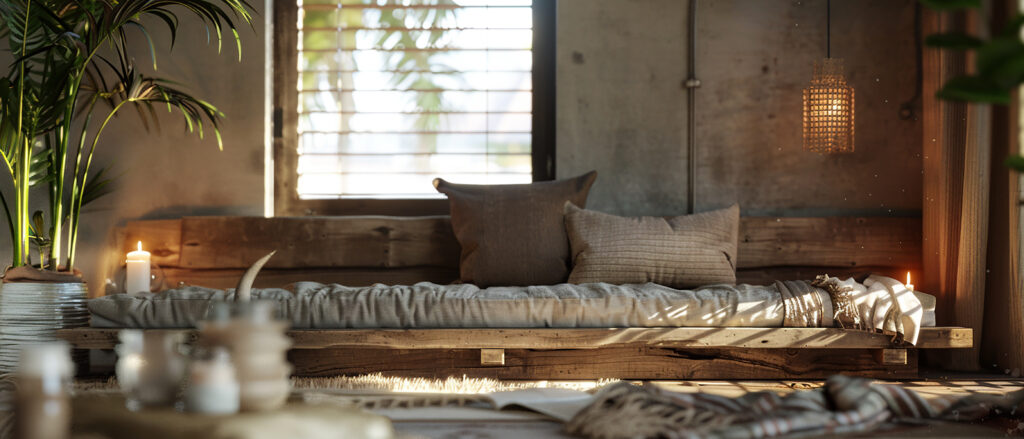Establishing a dedicated meditation space in your home can transform your practice and deepen your connection to mindfulness. A thoughtfully designed meditation area is a sanctuary for daily practice and a visual reminder of your commitment to inner peace. Let’s explore how to create a space that nurtures your meditation journey and supports your spiritual growth.
The Importance of Sacred Space
Creating a dedicated meditation space goes beyond simple aesthetics. Research shows that having a specific area for meditation helps establish a routine, deepen practice, and create positive associations that make it easier to maintain a regular meditation habit. Your meditation space becomes a physical anchor for your practice, helping your mind and body transition more quickly into a meditative state.
Choosing the Perfect Location
The foundation of your meditation space begins with selecting the right location within your home. Look for a quiet corner or area where you can practice undisturbed. Natural light can enhance the space’s energy, but it’s not essential – what matters most is finding a spot where you feel comfortable and at peace. Consider room temperature, air circulation, and ambient noise levels when choosing your location.
Even a small area can become a powerful meditation space. Whether you have an entire room or just a corner of your bedroom, the key lies in creating boundaries that separate your meditation area from the rest of your living space. This physical separation helps create a psychological shift when you enter your practice space.
Essential Elements for Tranquility
Comfort forms the cornerstone of an adequate meditation space. Invest in proper seating that supports good posture while remaining comfortable for extended periods. This might be a traditional meditation cushion (zafu), a bench, or a comfy chair. The goal is to find seating that allows you to maintain alertness while remaining relaxed.

Natural elements can significantly enhance the peaceful atmosphere of your meditation space. Consider incorporating plants, which purify the air and bring living energy to the space. A minor water feature can provide gentle, ambient sound that helps mask household noise and creates a sense of serenity. Natural materials like wood, stone, or bamboo can help ground your space and connect it to the earth.
Creating Atmosphere Through Sensory Elements
The atmosphere of your meditation space greatly influences your practice. Soft, natural lighting creates a calming environment – consider using dimmable lamps or candles to adjust the lighting based on the time of day and your preferences. If you use artificial lighting, opt for warm tones that mimic natural light.
Sound plays a crucial role in creating a meditative atmosphere. While complete silence works for some, others find gentle background sounds helpful. Consider incorporating a small sound system for meditation music, nature sounds, or guided practices. Wind chimes can add a peaceful element while also helping to mask unwanted noise.
Personal Touches That Enhance Practice
While simplicity remains important, personal touches can make your meditation space more meaningful. Consider adding items that hold spiritual significance or inspire your practice – perhaps a tiny altar, meaningful artwork, or objects from nature. These elements should support rather than distract from your practice.
Color choice significantly impacts the energy of your space. Soft, neutral tones generally create a sense of calm, while earth tones can help ground your practice. Consider using colors that resonate with you while maintaining a sense of serenity.
Practical Considerations for Daily Use
Storage solutions help maintain the serenity of your space. Include discrete storage for meditation props, blankets, and any other items you regularly use in your practice. Having everything you need within easy reach helps minimize distractions once you begin meditation.
Temperature control contributes significantly to comfort during meditation. Keep a light blanket or shawl nearby for cooler moments, and consider airflow when positioning your space. The goal is to create an environment where physical comfort supports rather than distracts from your practice.
Maintaining Your Sacred Space
Regular maintenance of your meditation space helps preserve its peaceful energy. Develop simple rituals for cleaning and refreshing your space – perhaps lighting a candle before practice or tidying the area afterward. These small acts of care can become part of your meditation practice, helping to maintain the sanctuary you’ve created.
Growing with Your Practice
Allow your meditation space to evolve with your practice. As you meditate more, you’ll discover what elements enhance or detract from your experience. Feel free to make adjustments and refinements over time, always remembering that the space should serve your practice rather than become a distraction from it.
Remember, creating a meditation space is a personal journey. While these guidelines provide a framework, trust your intuition about what feels right for your practice. The most important aspect is that the space supports your meditation journey and helps you maintain a consistent practice.

